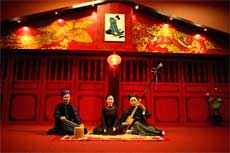 The Thang Long Ca Tru school is developed from the Thang Long Ca Tru club founded in August, 2006.
The Thang Long Ca Tru school is developed from the Thang Long Ca Tru club founded in August, 2006.
Among artists, researchers, musicians and audiences at the debut
ceremony were Prof Tran Van Khe, who has made active contributions to
promoting Ca Tru abroad, and music researcher Dang Hoanh Loan, who
involved in developing documents on the ceremonial songs to submit for
UNESCO’s recognition as the world cultural heritage in 2009.
Prof. Tran Van Khe described the establishment of the Thang Long Ca
Tru school as an effort in making the art prosper and reviving a type of
traditional art activity in former Thang Long.
Ca Tru (ceremonial singing) was listed as a cultural heritage in need
of urgent protection by UNESCO at the fourth session of UNESCO
inter-governmental committee for the Safeguarding of Intangible Heritage
in Abu Dhabi September 30, 2009.
‘Ca Tru’, also known as hat a dao or hat noi (ceremonial singing)
which dates back to the 15th century, has also been listed among 12
intangible global cultural heritage traditions in danger of
disappearing.
Ca Tru, like many old and highly developed arts, has many forms.
However, the most widely known and widely performed type of ca tru
involves only three performers: the female vocalist, a lute player and a
spectator (who also takes part in the performance).
The female singer provides the vocals whilst playing her phach (small
wooden sticks beaten on a small bamboo box to serve as percussion). She
is accompanied by a man who plays the dan day, a long-necked,
three-string lute used almost exclusively for the ca tru genre.
Last is the spectator (often a scholar or connoiseur of the art) who
strikes a trong chau (praise drum) in praise (or disapproval) of the
singer’s performance, usually with every passage of the song. The way in
which he strikes the drum provides commentary on the performance, but
he always does it according to the beat provided by the vocalist’s phach
percussion.